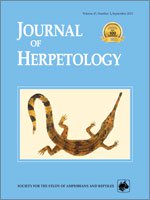Plethodontid salamanders in general and the genus Desmognathus in particular exhibit extreme morphological conservatism and rampant homoplasy so that cryptic lineages are common. In spite of this, multivariate morphometric analysis has proven a useful tool in detecting subtle morphological differences among cryptic forms. We used this technique to investigate subtle differences in morphology among populations of Desmognathus quadramaculatus (Black-bellied Salamander) and its cryptic congener, Desmognathus folkertsi (Dwarf Black-bellied Salamander). We found significant morphological variation among five populations of D. quadramaculatus but not between two populations of D. folkertsi. We also determined there to be a significant, albeit weak, correlation between genetic distance and morphological (Mahalanobis) distance. Given the relationship between genetic and morphological distance, the high morphological variation within D. quadramaculatus, relative to that within D. folkertsi, is not surprising. What is surprising is the significant amount of morphological divergence among populations of D. quadramaculatus within the same stream system. This result indicates that morphological variables may be more labile than is generally believed given the morphological conservatism of Desmognathus. While two cryptic species such as these might be expected to exhibit character displacement in morphology in areas of sympatry, we found no evidence of this.
How to translate text using browser tools
1 September 2013
Morphological Variation in the Cryptic Species Desmognathus quadramaculatus (Black-bellied Salamander) and Desmognathus folkertsi (Dwarf Black-bellied Salamander)
Carlos D. Camp,
Zackary L. Seymour,
Jessica A. Wooten
ACCESS THE FULL ARTICLE

Journal of Herpetology
Vol. 47 • No. 3
September 2013
Vol. 47 • No. 3
September 2013




